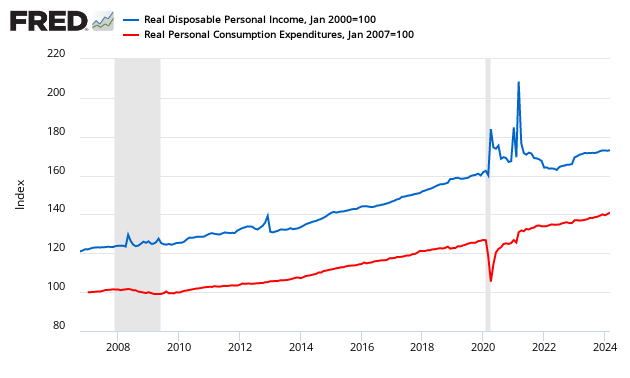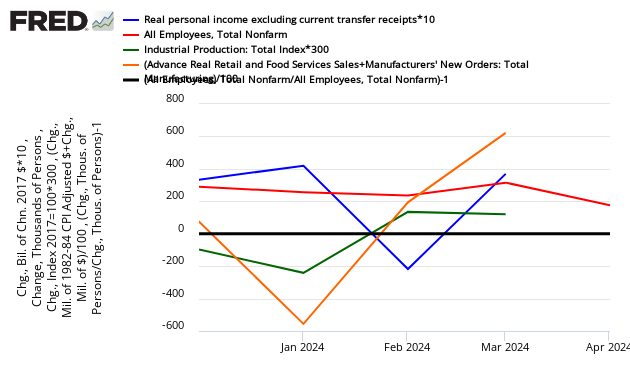Personal Income And Expenditures Disappoint, Growth Of Consumer Spending Is Slowing
This noisy data series came in below expectations. Consumer spending growth declined relative to last month - and has been growing slower and slower year-over-year relative to the growth of income.

- The market looks at current values (not real inflation adjusted) and was expecting:.

- In other words, both income and spending were below expectations.
- The monthly fluctuations are confusing. Looking at the inflation adjusted 3 month trend rate of growth, income trend is downward and expenditures is also trending down.
- Real Disposable Personal Income is up 2.5% year-over-year, and real personal expenditures is up 2.1% year-over-year (table 10).
- this data is very noisy and as usual includes moderate backward revision (detailed below) - this month the changes were slight.
- The advance estimate of 3Q2014 GDP indicated the economy was growing at 3.5% (quarter-over-quarter compounded). Expenditures are counted in GDP, and income is ignored as GDP measures the spending side of the economy. However, over periods of time – income and expenditure must grow at the same rate. Usually this differential signals a future slowdown of consumer spending growth.
- The savings rate continues to be low historically, but improved this month.

The inflation adjusted income and consumption are “chained”, and headline GDP is inflation adjusted. This means the impact to GDP is best understood by looking at the chained numbers. Econintersect believes year-over-year trends are very revealing in understanding economic dynamics.
Per capita inflation adjusted expenditure has exceeded the pre-recession peak.
Seasonally and Inflation Adjusted Expenditure Per Capita

Per capita inflation adjusted income is above pre-recession levels.
Seasonally and Inflation Adjusted Income Per Capita

Backward revisions this month:
Estimates have been revised for July and August. Changes in personal income, in current-dollar and chained (2009) dollar DPI, and in current-dollar and chained (2009) dollar PCE for July and August -- revised and as published in last month's release -- are shown below.

The graph below illustrates the relationship between income (DPI) and expenditures (PCE) – showing clearly income and expenditures grow at nearly the same rate over time. In dollar terms, incomes are now growing faster than consumer expenditures – and this is positive for long term economic growth (as future spending is being banked).
Indexed to Jan 2000, Growth of Real Disposable Income (blue line) to Real Expenditures (red line)

The long term trend remains that the consumer is spending more of its income - although the growth rate has been in a tight range for over one year.
Seasonally Adjusted Spending’s Ratio to Income (a declining ratio means consumer is spending less of its Income)

PCE is the spending of consumers. In the USA, the consumer is the economy. Likewise, personal income is the money consumers earn to spend. Even though most analysts concentrate on personal expenditures because GDP is based on spending, increases in personal income allow consumers the option to spend more.
There is a general correlation of PCE to GDP (PCE is a component of GDP). PCE is not very noisy compared to GDP, but subject at times to significant backward revision (see caveats below).
Seasonally and Inflation Adjusted Year-over-Year Change of Personal Consumption Expenditures (blue line) to GDP (red line)

Econintersect and GDP uses the inflation adjusted (chained) numbers. Disposable Personal Income (DPI) is the income after the taxes.
Seasonally & Inflation Adjusted Percent Change From the Previous Month – Personal Disposable Income (red line) and Personal Consumption Expenditures (blue line)

Yet year-over-year growth is not exceptional with both consumption and income near year-over-year GDP growth.
Seasonally & Inflation Adjusted Year-over-Year Change – Personal Disposable Income (red line) and Personal Consumption Expenditures (blue line)

The savings rate has been bouncing around – but the general trend is down. In an economy driven by consumers, a higher savings rate does not bode well for increased GDP. This is one reason GDP may not be a good single metric of economic activity. The question remains what is the optimal savings rate for the current demographics. It might be expected that as people near retirement, the savings rate rises and after people retire, savings rate falls. Econintersect is not aware of any study which documents this effect. The graph below is from BEA table 2.6. – and shows a significant fall in savings rate in January 2013 which has not been recovered – and now remains range bound. The savings rate is now 5.6% – last month was 5.4%.
Personal Savings as a Percentage of Disposable Personal Income

And one look at the different price changes seen by the BEA in this PCE release versus the BEA’s GDP and BLS’s Consumer Price Index (CPI). We should note that the inflation adjustment is for PCE and Personal Income is lower than the ones used for GDP and CPI.
Year-over-Year Change – PCE’s Price Index (blue line) versus CPI-U (red line) versus GDP Deflator (green line)

Finally for recession watchers, here is the graph below, here are the elements used to mark a recession. (1) personal income less transfer payments, in real terms and (2) employment. In addition, we refer to two indicators with coverage primarily of manufacturing and goods: (3) industrial production and (4) the volume of sales of the manufacturing and wholesale-retail sectors adjusted for price changes.
If a line falls below the 0 (black line) – that sector is contracting from the previous month. Personal income is the blue line. Note – the below graph uses multipliers to make movements more obvious (ignore the value of the scale, only consider whether the graph is above [good] or below [bad] the zero line).
Month-over-Month Growth Personal Income less transfer payments (blue line), Employment (red line), Industrial Production (green line), Business Sales (orange line)

Caveats on the Use of Personal Income and Consumption Expenditure Data
PCE is a fairly noisy index and subject at times to significant backward revision. This index cannot be relied upon in real time.
This personal income and personal consumption expenditure data by itself is not a good tool to warn of an upcoming recession. Econintersect has shown that PCE is a distraction for recession watchers, with moves over a few months having a 30% accuracy of indicating a recession start, and a 70% incidence of indicating a non-recessionary event. The graph below shows the lack of correlation. Note, however, that PCE does have prolonged declines over many months associated with recessions but these long declines are not very good in “predicting” a recession until it is already underway.

Readers are warned that this article is based on seasonally adjusted data. Monthly non-adjusted data is available with a delay of several months.
Disclosure: None.



